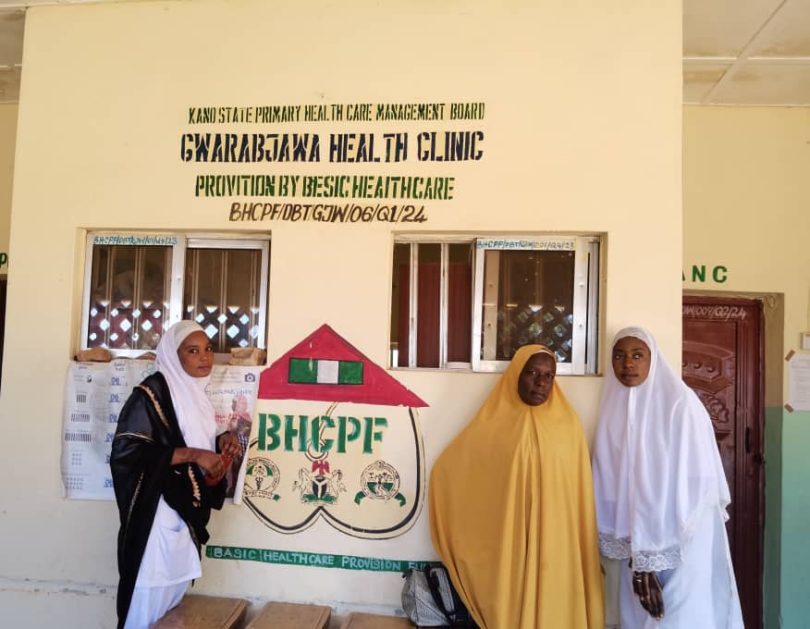Photo: The Gwarabjawa PHC in Dambatta LGA, Kano state, is in the scheme
With a budgetary provision of ₦1.61 trillion for the Federal Ministry of Health and Social Welfare in the 2025 national budget, Professor Muhammad Ali Pate, the Coordinating Minister of Health and Social Welfare should be hyper-busy in seeking cash-backing and releases for running the sensitive health and social welfare sector.
He said that ₦32.9 billion of that money was recently released for the provision of Basic Minimum Package of Health Services (BMPHS) and remitted to some of the 8,309 Primary Health Care Centres (PHCs) in Nigeria, including those in remote and underserved communities.
The Minister said in a media statement styled “The Red Letter” on October 22, 2025 that, the ₦32.9 billion was the third tranche released to the Ministry. Professor Pate had in August 2025 disclosed that between 2023 to that month, ₦50 billion was received by the Ministry in two trenches. He said that the money was directly sent to the PHCs nationwide.
“This fund is the heartbeat of Nigeria’s renewed hope in health—a signal that government is not only fulfilling its responsibility as the custodian of the fund, but trusting you to help safeguard that spending,” he wrote.
Although many of the PHCs built to achieve the health component of the Millennium Development Goals (MDGs) were vandalised by thieves or severely degraded by the elements. Professor Pate reported that the administration of President Bola Tinubu has released ₦20 billion for the rehabilitation and upgrading of 4,362 PHCs in the country.
He said that the verifiable rehabilitation and upgrading of the dilapidated PHCs “has led to the qualitative modernisation of health infrastructure across all local government areas of Nigeria.”
In September 2025, Dr Muyi Aina, the Executive Director of the National Primary Health Care Development Agency (NPHCDA), informed Nigerians that the Federal Government has cumulatively spent over ₦192 billion to strengthen primary healthcare facilities across Nigeria since the Basic Health Care Provision Fund (BHCPF) started disbursements in 2019.
Dr. Aina explained that the quarterly allocation to PHCs is varried based on certain criteria, “Allocations were recently scaled up from an average of N300,000 to between N600,000 and N800,000 per quarter, depending on facility size and patient volume.”
“Even though budget allocations are growing, the cost of healthcare delivery, vaccines, TB medicines, malaria commodities and operational programmes is rising even faster,” the Executive Director said.
With a reported visits of 37 million patients to PHCs for basic treatment in the first quarter of 2025 alone, it is obvious that the Centres deserve more government attention and additional resources to serve the public better.
To use the funds provided to the PHCs transparently, Professor Pate said residents of communities should be involved in certifying that the money is used solely to address priority healthcare needs.
“Stand up and take ownership (of the health facility). Join the committee. Demand openess,” the coordinating Minister for health urged Nigerians in the “The Red Letter.”
“The health committee in your ward, your traditional leaders, your women’s and youth groups, your faith-based organisations—all of you are meant to sit together, decide together, and spend together on what will make your facility stronger, safer, and more ready to serve,” Professor Pate emphasised.
At the Gwarabjawa PHC near Dambatta, which this author visited on October 29, 2025, it was confirmed that the community has a health committee. There is a board on which information concerning activities in the Centre were displayed.
But in countless other communities regular citizens are rarely involved in the affairs of their PHCs.
Providing Basic Minimum Package of Health Services (BMPHS), reducing the prevalence and burden of treating malaria and typhoid, tuberculosis, measles, respiratory infections, diphtheria and whooping cough coild be substantially achieved if PHCs operate in line with the content of Professor Pate’s “The Red Letter.”
Salisu Na’inna Dambatta is an advocate for healthcare journalism

